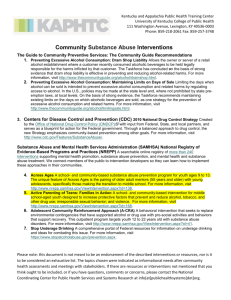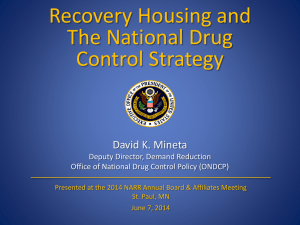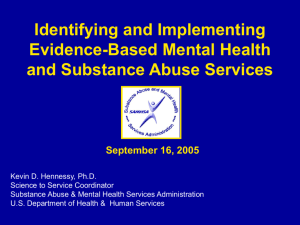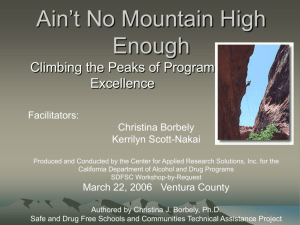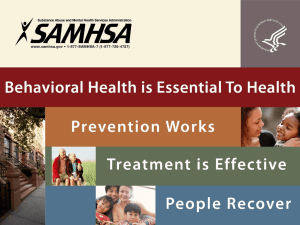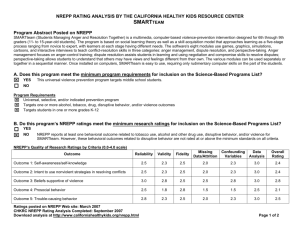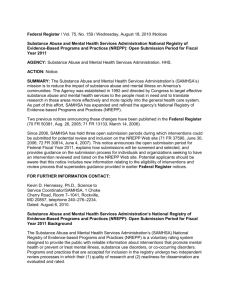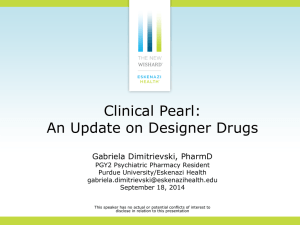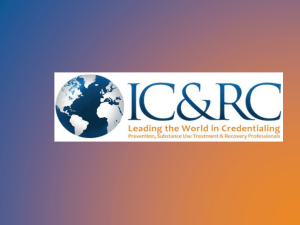Question 25 Reference Guide
advertisement
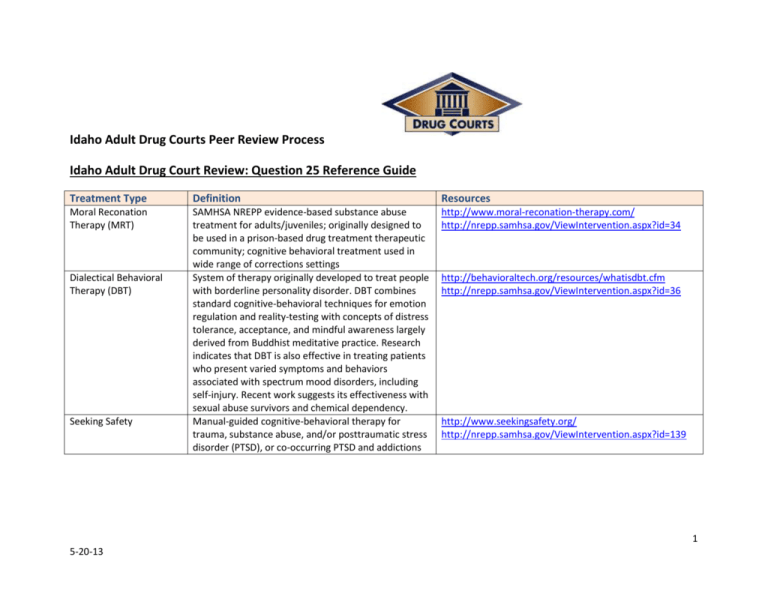
Idaho Adult Drug Courts Peer Review Process Idaho Adult Drug Court Review: Question 25 Reference Guide Treatment Type Definition Resources Moral Reconation Therapy (MRT) SAMHSA NREPP evidence-based substance abuse treatment for adults/juveniles; originally designed to be used in a prison-based drug treatment therapeutic community; cognitive behavioral treatment used in wide range of corrections settings System of therapy originally developed to treat people with borderline personality disorder. DBT combines standard cognitive-behavioral techniques for emotion regulation and reality-testing with concepts of distress tolerance, acceptance, and mindful awareness largely derived from Buddhist meditative practice. Research indicates that DBT is also effective in treating patients who present varied symptoms and behaviors associated with spectrum mood disorders, including self-injury. Recent work suggests its effectiveness with sexual abuse survivors and chemical dependency. Manual-guided cognitive-behavioral therapy for trauma, substance abuse, and/or posttraumatic stress disorder (PTSD), or co-occurring PTSD and addictions http://www.moral-reconation-therapy.com/ http://nrepp.samhsa.gov/ViewIntervention.aspx?id=34 Dialectical Behavioral Therapy (DBT) Seeking Safety http://behavioraltech.org/resources/whatisdbt.cfm http://nrepp.samhsa.gov/ViewIntervention.aspx?id=36 http://www.seekingsafety.org/ http://nrepp.samhsa.gov/ViewIntervention.aspx?id=139 1 5-20-13 Treatment Type Definition Resources Recovery Training and Self Help Group aftercare program for individuals recovering from opioid addiction. RTSH is designed to deactivate addiction by teaching and supporting alternative responses to stimuli previously associated with opioid use. Program goals include reducing the occurrence and frequency of relapse and readdiction and helping unemployed participants obtain employment. Communication and decision-making technique designed to support delivery of treatment services by improving client and counselor interactions through graphic visualization tools that focus on critical issues and recovery strategies. As a therapeutic tool, it helps address problems more clearly than when relying strictly on verbal skills. Mapping-Enhanced Counseling is the cognitive centerpiece for an adaptive approach to addiction treatment that incorporates client assessments of needs and progress with the planning and delivery of interventions targeted to client readiness, engagement, and life-skills building stages of recovery. Brief, structured, and manual-driven approach to facilitating early recovery from alcohol abuse, alcoholism, and other drug abuse and addiction problems; active engagement strategy designed to increase the likelihood of a substance abuser becoming affiliated with and actively involved in 12step self-help groups and, thus, promote abstinence. http://www.sciencedirect.com/science/article/pii/074054 7286900036 http://nrepp.samhsa.gov/ViewIntervention.aspx?id=61 TCU (Texas Christian University) MappingEnhanced Counseling Twelve Step Facilitation Therapy http://www.ibr.tcu.edu/pubs/trtmanual/manuals.html http://nrepp.samhsa.gov/ViewIntervention.aspx?id=161 http://www.drugabuse.gov/publications/principles-drugaddiction-treatment/evidence-based-approaches-to-drugaddiction-treatment/behavioral-therapies/1 http://nrepp.samhsa.gov/ViewIntervention.aspx?id=55 2 5-20-13 Treatment Type Definition Resources Community Reinforcement Approach Alcoholism treatment approach that aims to achieve abstinence by eliminating positive reinforcement for drinking and enhancing positive reinforcement for sobriety. Comprehensive cognitive-behavioral intervention for the treatment of substance abuse problems. CRA seeks to treat substance abuse problems through focusing on environmental contingencies that impact and influence the client's behavior. The systematic reinforcement of desired behaviors and the withholding of reinforcement or punishment of undesired behaviors, is an effective strategy in the treatment of alcohol and other drug (AOD) use disorders. Studies have demonstrated the effectiveness of CM interventions in reducing AOD use; improving treatment attendance; and reinforcing other treatment goals, such as complying with a medication regimen or obtaining employment. Teaches offenders convicted of violent offenses how to identify thoughts and attitudes that lead them to do violent acts, and teaches them how to find and use new thoughts and attitudes that don't. Intensive outpatient treatment approach for stimulant abuse and dependence. The intervention consists of relapse-prevention groups, education groups, socialsupport groups, individual counseling, and urine and breath testing. The program includes education for family members affected by the addiction. The therapist functions simultaneously as teacher and coach, fostering a positive, encouraging relationship with the patient and using that relationship to reinforce positive behavior change. http://pubs.niaaa.nih.gov/publications/arh23-2/116121.pdf http://www.cebc4cw.org/program/communityreinforcement-approach/ http://nrepp.samhsa.gov/ViewIntervention.aspx?id=41 Contingency Management Cognitive Self-Change (CSC) Matrix Model http://pubs.niaaa.nih.gov/publications/arh23-2/122127.pdf http://nrepp.samhsa.gov/ViewIntervention.aspx?id=146 http://www.doc.state.vt.us/programs/cognitive-selfchange-a-program-for-violent-offenders/cognitive-selfchange-1 http://www.vtfa.com/publications/csc.pdf http://www.matrixinstitute.org/about/about.html http://nrepp.samhsa.gov/ViewIntervention.aspx?id=87 3 5-20-13 Treatment Type Definition Resources The Seven Challenges Designed to treat adolescents with drug and other behavioral problems. Counselors and clients identify the most important issues at the moment and discuss these issues while the counselor seamlessly integrates a set of concepts called the seven challenges into the conversation. Skills training, problem solving, and sometimes family participation are integrated into sessions. Uses journaling process. The program can be implemented in an array of settings, including inpatient, outpatient, home-based, juvenile justice, day treatment, and school. http://www.sevenchallenges.com/About.aspx http://www.nrepp.samhsa.gov/ViewIntervention.aspx?id= 159 4 5-20-13
